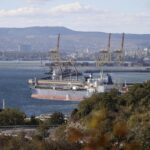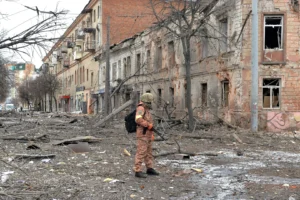The spectacular Northern Lights that were on display across the country last night were caused by radiation “being blown off the sun”, according to Astronomy Ireland, and could appear for a second night in a row tonight.
The natural light display, also known as the Aurora Borealis, is the result of collisions between gas particles in our atmosphere and charged particles ejected from the sun’s atmosphere.
CEO of Astronomy Ireland David Moore said there is a chance the Northern Lights could repeat this evening after the sunset.
“There is a small prediction, not as good as last night. Predictions are not certain,” he explained.
However, he would still encourage people to watch out for the Northern Lights tonight.
“The light gets from the sun in about eight minutes.
“It takes two days for the actual radiation particles to travel from the Sun to Earth, and so we have this two-day warning.
“That’s how we’re able to predict that yesterday and tell everybody to be ready,” he explained.
In Norway, the Northern Lights are visible every night, especially inside the Arctic Circle.
Meanwhile, in Ireland, the Aurora Borealis could happen every couple of months, Mr Moore said.
“This far south away from the North Pole, we probably only get them about 1pc of the time or 100 times less frequently.
“You see it every three months perhaps on average, but you could see one or two at the weekend, then nothing for six months,” he said.
The biggest factor is the unpredictability of Irish weather.
“That can be a real problem because, for astronomers in Ireland, the weather forecast is really simple and has two words: ‘every day’ or ‘mostly cloudy’,” he said.
Despite that, Astronomy Ireland encourages everybody in the country to watch and look out for the Northern Lights as someone might “get a break in the clouds” and see it.
“It might be in the north, south, west or the east.
“I recommend people to watch, but it could be that Aurora is now over.
“It’s not really predictable. It’s like storms – we might get many storms in a week, and then not get any for months.
“We leave it to the professional astronomers at NASA that will have the spacecraft monitoring the sun, and they were pretty confident last night that would be an Aurora.
“Sometimes, there’s a very compact stream of radiation from the sun.
“There were multiple explosions on the Sun, and they could be producing multiple events.
“The explosions on the Sun don’t really have an upper limit. There are a lot of pops and cracks all the time,” Mr Moore added.
Last night, people across Ireland marvelled at the spectacular sight as the colours were visible across the night’s sky.
Irish people shared their photos and videos of the marvellous views across social media platforms.
The posted pictures came from Wexford, Sligo, Cork, Skerries, Donegal or Dún Laoghaire in Dublin.
The Northern Lights are often visible in Donegal, however the sky last night was also bright and colourful down in Kerry and Cork.
“Donegal is a great place to see it, but the reason is not because it’s in the north.
“The reason is that they’ve got the Atlantic Ocean, so there are no streetlights in that direction.
“Point your cameras and there’s nothing but ships and sea,” he said.
Another example of such a place is Mayo. Meanwhile, Dubliners don’t see the Northern Lights as often.
“A lot of people in Dublin are trapped by the hundreds of thousands of street lights,” he explained.
Mr Moore said there is a permanent Aurora over Dublin.
“If you went to the Phoenix Park last night, you almost certainly would have seen the aurora.
“Aurora is changing, sometimes it surges,” he said.
Astronomy Ireland is appealing for people who took photographs of the Aurora to send them as they have a chance to be featured in the Astronomy Ireland Magazine. Contact details are available on their website astronomy.ie.
Source : Independent











